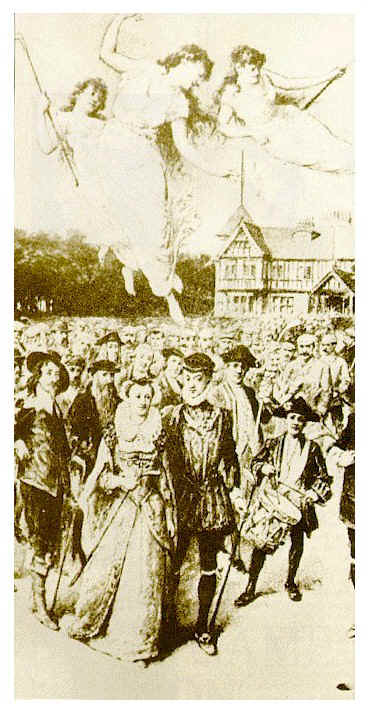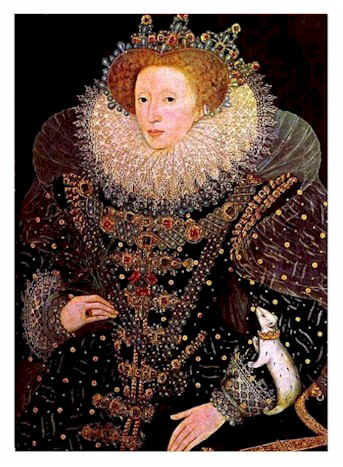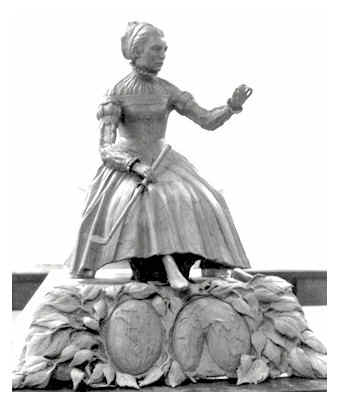|

History of Golf
Mary Stuart Queen of Scots

(1542-1587)
Mary at 13 years of age
Few individuals in human history have been born
to such a privileged position and had such a promising beginning
in life only to have their lives come to such a tragic end
as did Mary Queen of Scots.
Mary was born to Scottish Royalty with family
ties through her mother to one of the most powerful families in
France, The House Of Guise, and through her first marriage to the
Dauphin/heir to the throne of France, to one of the most powerful
families in Italy, the House of Medici. The Dauphin's mother being
Catherine Medici and his great grandfather being Lorenzo the Magnificent
of the House of Medici patron of Michelangelo and Leonardo da Vinci
and patriarch of the wealthiest and most politically influential
family in Italy.
The story of Mary and the drama of her life
developed primarily because she had direct ties to the English Throne
through her ancestry. Margaret Tudor, sister of King Henry VIII,
had married James IV, the King of Scotland, and had birthed
their son James V. James V married Mary of Guise, and Mary Queen
of Scots was born into this union in 1542. Her father James V of
Scotland died within a week of Mary's birth which immediatlely made
her the Queen of Scotland. Because of her young age her mother ruled
as regent while Mary was sent to France for her formal education.
Henry VIII of England had treid to legally arrange
the marriage of his son Edward VI to Mary by the Treaties of Greenwich
however the terms were not acceptable and the Scottish Parliment
did not approve of the Union. Henry became upset and started aggressions
against Scotland and Mary was sent to France to the Royal Court
for her own protection and education.
Mary was raised in the French Court
which was Catholic and her first husband was Francis II, was the
Dauphin/heir to the throne of France. At the age of 15 she
was married to Francis II, the son of Henri II of France and
Catherine Medici. The young couple had been playmates while
growing up together in the French Court. This union lasted
only two years ending with the death of Francis II when Mary was
age 17.
Upon the death of her first Husband she no longer
had a claim to be the Queen of France. The French court became politically
dominated by her mother in law Catherine. Instead of staying in
France and dealing with unfavorable political circumstances upon
the death of Mary's mother she chose instead to return to Scotland
in 1560 and claim the rule of Scotland as her rightful inheritance.
This decision to a large degree marked the beginning of her personal
misfortunes that ultimately lead to her captivity in England and
her eventual execution.

A romanticized version of Mary Queen of Scots
playing golf on the Scottish Links
During the 16th century the game of golf had become
firmly established on the east coast of Scotland and began to spread
further abroad. Mary Queen of Scots, was a notable player. So keen
was her interest in the game that she fell foul of the Church and
Scottich Nobles for playing golf only a few days after the murder
of her husband, Lord Darnley, rather than demonstrating a proper
amount of time in mourning following his murder and death.
Following the Death of Lord Darnley Mary married
again however her third marriage put her in conflict with other
Scottish Nobles. It was suspect that Mary had in fact arranged the
assasination of lord Darnley and she was asked to abdicate the Scottish
throne. Seeking asylum from her problems in England lead to
18 years of house arrest by Elizabeth I of England.
In England Mary was ultimately accused and tried
for treasonous activities against the throne of England and beheaded
on Feb. 8th 1587 .
Her execution caused an absolute outrage throughout
Catholic Europe. The invasion of the Spanish Armada in 1588
by Philip II of Spain was motivated partially to avenge her
death and its goal was to depose Elizabeth I and return the throne
of England to the Catholic Church, however the Spanish Armada itself
failed in its mission.
It is important to note that the plan to launch
the Spanish Armada may have in fact been influenced by Catherine
of France Mary's mother in law by her first marriage to Francis
II of France. Catherine's daughter was married to Phillip II of
Spain at the time the Armada was launched. Following the Spanish
invasion attempts the Catholic Church's claim of ascendancy to the
throne of England was to be dealt with much more severity by the
authorities of the English Crown and the Anglican Church. This policy
of the English Crown lead directly to formal patronage of the protestant
reformation in England.
The Protagonists

Elizabeth I portrait dating 1585

1585 Portrait of Mary during her captivity
by Francois Clouet
Perhaps the most famous image of Mary, it was painted
during her imprisonment in England. The artist is Nicholas Hilliard.
This image was copied frequently during the reign of her son King
James I of England and the Patron who published the King James Version
of the Bible.
Mary's son King James VI of Scotland (James
I of England) became a convert to the game of golf before he acceded
to the English throne as James I in 1603.

Sculpture by Chester Comstock dated 1986
Mary Queen of Scots contemplating a Golf ball
as if it were a globe.
Trophy Proposed for the International at Castle Pines Golf
Club
About the Art
The above sculpture was created and
submitted by Chester Comstock to the selection committee as
a conceptual for the first place trophy for the International, a
PGA tour event held at Castle Pines Golf Club in Castle Rock Colorado.
The sculpture was designed to convey the concept
of the expansion of golf from its earliest origins in Scotland,
to its truly International Status as a gentleman's sport.
During Mary's interment in England Sir Francis
Drake had just circumnavigated the globe in the Golden Hind. This
is an event that Mary surely had news of and which sparked global
ambitions of Empire for the rulers of England.
The sculpture shows Mary contemplating a golf
ball as if it were a globe, artistically suggesting her inner desire
for the expansion of her personal dominion, the promise of which
plunged her into direct political conflict with her cousin Queen
Elizabeth I of England.
Although Mary's political aspirations lead directly
to the turmoil which ultimately endangered and ended her life, her
promotion of and favor for the game of golf is now truly shared
Internationally.
For additional historical background on 16 and
17 the century Globalization of trade visit these pages:
The life and times of St. Francis Xavier, 1512- 1552
Page:
1
Xavier meets Otomo Sorin the King of Bungo,1550
Page:
2
William Adams arrives in Japan, 1600
Page:
3
The Epic Journey of Hasekura Tsunenaga, 1613-1620
Page:
4
James I king of England (1603-1625) and his personal
correspondence with Tokugawa Ieyasu Shogun of Japan 1600-1616
Page:
5
For information about the art Call: (303) 657 9778
|
